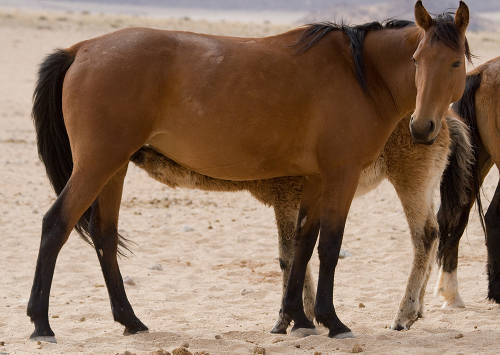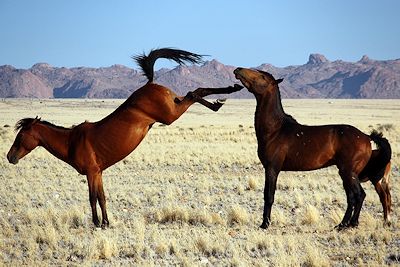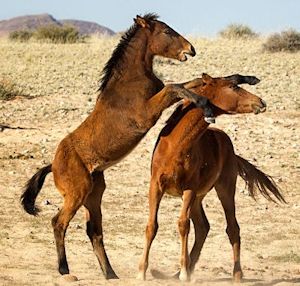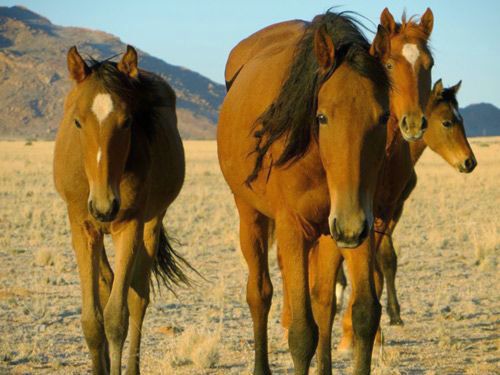The Namib Desert Horse is a rare feral horse found in the Namib Desert of Namibia, Africa, and is thought to be the only feral herd of horses residing in Africa.

For centuries their origin was shrouded in mystery. Their habitat, the barren plains around Garub on the eastern fringe of the Namib Desert (part of the Namib-Naukluft Park), is no paradise. Nevertheless, they have managed to adapt to the harsh conditions and the arid land.
The home range of the Namib Desert Horse reaches north in the Namib Desert to the Koichab River, (which is usually dry), and west to the Great Escarpment. Bands of horses range together, consisting of as few as two animals, although there are generally more. In observations between 1993 and 2003, between six and eleven bands were identified, including a mixture of bachelor herds, breeding groups, and co-operating stallion groups (groups with more than one stallion that share breeding duties). A number of paired individuals have been documented staying together for 5 to 7 years.
Theories on the origin of the Namib Wild Horse Herd
 There are several theories on the origin of the Namibia wild horse herd. The least likely theory is that they are descendants of Thoroughbred horses that survived a ship wreck in the late 19th century near the Orange River (200km or 125 miles from Garub). It would be unusual for horses to cover such great distances.
There are several theories on the origin of the Namibia wild horse herd. The least likely theory is that they are descendants of Thoroughbred horses that survived a ship wreck in the late 19th century near the Orange River (200km or 125 miles from Garub). It would be unusual for horses to cover such great distances.
Another theory states that they descend from Cape horse/Basuto pony crosses ridden by Khoikhoi raiders traveling from southern Africa to north of the Orange River.
The Namib Desert Horse phenotypically more closely resembles the horses bred by von Wolf and ridden by the World War I-era troops than the horses ridden by Khoikhoi tribesmen, making the following story the more likely. The genetic evidence of the 2001 study gave less credence to the descent from von Wolf’s horses. He used Thoroughbreds, Hackneys and Trakehners in his breeding program, rather than the Arabian horse to which the Namib Desert Horses are the most genetically similar.
Yet another theory mentions that the German Schutztruppe had about 2000 horses (probably Trakehner) stationed near Aus during WWI and when they had to retreat before the South African troops, they just left behind their horses. However, the retreat for the most part, was carried out in an orderly manner.
At the same time some reports state that there were even more horses in the area: 10,000 South African soldiers with their 6,000 horses had set up camp near Garub in March of 1915. A dug well existed at that location. It supplied water for the steam engines at the nearby railroad line. This means that there were about 8000 horses in all at the edge of the desert within a 30 km (18.6 mile) radius!
A military report, compiled later, states: “In the morning of March 27, the tireless flight lieutenant Fiedler flew to Garub and successfully dropped bombs on the enemy camp amidst 1700 grazing cavalry horses causing great confusion” (Hans von Oelhafen: Der Feldzug in Südwest 1914/15, Berlin 1923, page 117).
As the South Africans were about to start an offensive and were in a hurry to stay hot on the heels of the retreating German soldiers, some of the scattered horses might have been abandoned.
The amateur historian Walter Rusch discovered photo albums belonging to Emil Kreplin, mayor of Lüderitz between 1909 and 1914, depicting horses at a stud farm he founded in Kubub, south of Aus. Kreplin bred work horses for mining operations and in addition lighter race horses for the growing Lüderitz.
Photos of the stud horses of Kubub and Duwisib show remarkable similarities. Photos of the Kreplin breed show distinctive characteristics that are still prominent 90 years later in the wild horses of today. For the most part, these features are characteristic of the Cape Boer Horse, Hackney, and Trakehner.
Consequently, we can say it is likely that the core of the herd consisted of horses of the South African army and the German troops that fled to freedom after a bombing attack, and the Kreplin studs (with a possible connection with the breeding station of Hansheinrich von Wolf at Duwisib Castle).
Genetic testing of the Namib Desert Horse
 Genetic testing results published in 2001 indicated that Namib Desert Horses are one of the most isolated horse populations in the world, with the second-lowest genetic variation of all horse populations that have been studied to date. In part, this is due to their small founding population, and generally small modern population, made smaller during periods of drought.
Genetic testing results published in 2001 indicated that Namib Desert Horses are one of the most isolated horse populations in the world, with the second-lowest genetic variation of all horse populations that have been studied to date. In part, this is due to their small founding population, and generally small modern population, made smaller during periods of drought.
Despite the large domesticated breeding population from which the horses originally descended, at least one genetic bottleneck has occurred in the breed’s history, resulting in a significant decline in genetic variation over a relatively short period of time. Although an ideal minimum population size for genetic variability would be around 200 horses, the current range cannot support this population given the average rainfall. Estimates for a necessary minimum population to maintain genetic effectiveness range between 100 and 150 animals.
The 2001 testing showed the Namib Desert Horse to be part of the Oriental horse grouping, genetically closest to the Arabian horse, although even this association was distant. They were closer to the Arabian than to the three South African breeds tested, the Nooitgedacht pony, the Boer pony and the Basuto pony. As the genetic similarity to Arabian-type horses is distant, they do not closely resemble them in outward appearance, although they are both of the hot blooded type, resulting in both being athletic, lean-muscled animals.
In blood typing studies done in the 1990s, a new variant was noted. Its absence from the blood samples of all other horse breeds indicates the presence of a mutation that probably occurred after the horses became established in the desert.
A 1994 study found that they have an average home range of 13 square miles (34 km2), although not all of that is travelled each day. They must cover considerable distances, as much as 15 to 20 kilometres (9 to 12 mi) between the few existing water sources and the best grazing sources, which consumes a lot of their energy. This creates severe selection pressure and removes weak animals from the population.
Due to scarcity of water, the Namib Desert Horse on average goes without water for about thirty hours in summer and has been known to go close to 72 hours without water during the winter, significantly longer than most horses, even other feral herds.
A 1991 study suggested that in 75 years of genetic isolation and water scarcity the population had developed physiological mechanisms which improved their ability to conserve water. In 1993, a second study showed that the physiological water-conservation ability did not differ between Namib Desert Horses and other populations when dehydrated for periods of up to 60 hours, but suggested that the Namib Desert Horse would show improved conservation ability when dehydration periods were extended to upwards of 72 hours, a common occurrence in their feral state.
They regularly consume their own manure
The horses’ diet is made up predominantly of grass. They will also consume their dry nutrient-rich manure. This is a natural behaviour called coprophagy, an energy-efficient way of deriving nutrients, exhibited by a variety of animals and all horses if opportunity allows.
The Wild Horses’ manure contains almost three times more fat (1.99%) than the area’s dry grass (Stipagrostis obtusa – 0.7%) and almost twice as much protein (6.1 instead of 3.1%).
As horses don’t digest plant cellulose as efficiently as ruminants, the manure provides a high-energy food and a way of absorbing nutrients which have been excreted undigested. The manure, however, is merely a supplement; less than 1kg of manure is eaten for every 7kg of grass. In the dry Namib Desert, parasitic infestations are curtailed by the dry environment.
Foals, on the other hand, need to eat fresh manure to acquire the essential intestinal micro-organisms necessary for digestion.
Conformation and coloring of the Namib Wild Horses
The most common color of the Namib Desert Horse is bay, although there are a few chestnut and brown horses. The gene for gray does not occur in the breed. There are many individuals with dorsal striping but no zebra stripes. No other colors have been recorded.
The Namib Desert Horses are athletic, muscular, clean-limbed, and strong boned. They are short-backed with oblique shoulders and good withers. The horses have the appearance of well-bred riding horses in head, skin, and coat. Overall, they have good conformation, with few deformities. Club hooves are occasionally seen in foals, likely due to trauma to the hoof while traveling long distances
Although several attempts were originally made to exterminate the horses, due to a possible threat to oryx habitat and native plants, they are now protected by the South West Africa/Namibia Directorate of Nature Conservation. Today, the Namib Desert Horses are a popular tourist attraction which contribute a significant amount to the local economy.

